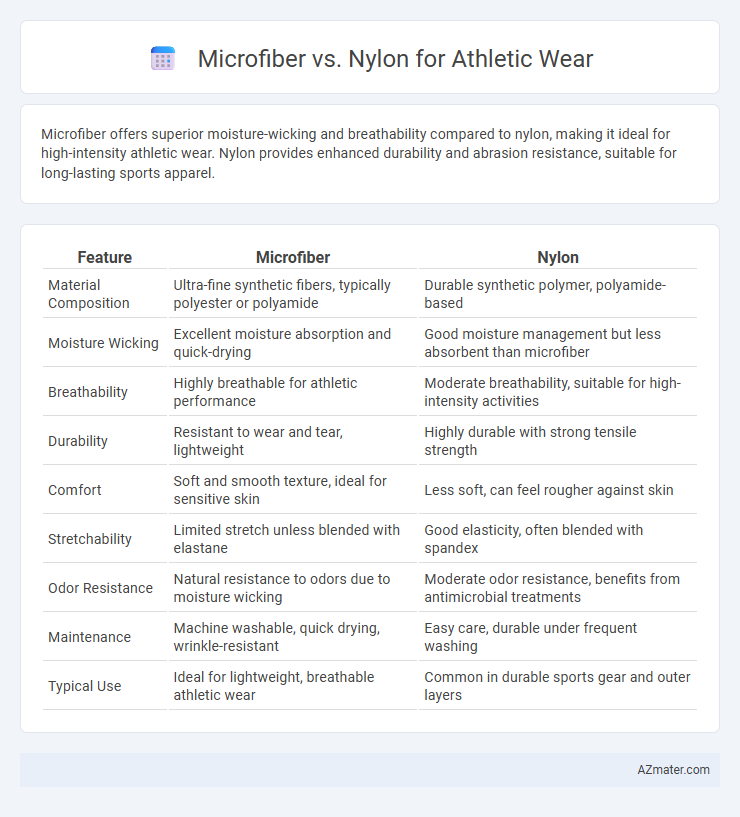Microfiber offers superior moisture-wicking and breathability compared to nylon, making it ideal for high-intensity athletic wear. Nylon provides enhanced durability and abrasion resistance, suitable for long-lasting sports apparel.
Table of Comparison
| Feature | Microfiber | Nylon |
|---|---|---|
| Material Composition | Ultra-fine synthetic fibers, typically polyester or polyamide | Durable synthetic polymer, polyamide-based |
| Moisture Wicking | Excellent moisture absorption and quick-drying | Good moisture management but less absorbent than microfiber |
| Breathability | Highly breathable for athletic performance | Moderate breathability, suitable for high-intensity activities |
| Durability | Resistant to wear and tear, lightweight | Highly durable with strong tensile strength |
| Comfort | Soft and smooth texture, ideal for sensitive skin | Less soft, can feel rougher against skin |
| Stretchability | Limited stretch unless blended with elastane | Good elasticity, often blended with spandex |
| Odor Resistance | Natural resistance to odors due to moisture wicking | Moderate odor resistance, benefits from antimicrobial treatments |
| Maintenance | Machine washable, quick drying, wrinkle-resistant | Easy care, durable under frequent washing |
| Typical Use | Ideal for lightweight, breathable athletic wear | Common in durable sports gear and outer layers |
Introduction to Athletic Wear Fabrics
Microfiber and nylon are two prominent fabrics used in athletic wear, each offering unique performance benefits. Microfiber is engineered from extremely fine synthetic fibers, providing exceptional moisture-wicking and breathability ideal for high-intensity workouts. Nylon delivers superior durability, elasticity, and abrasion resistance, making it a preferred choice for long-lasting activewear and support during rigorous physical activities.
What is Microfiber?
Microfiber is a synthetic fiber finer than one denier, commonly made from polyester or polyamide, prized for its lightweight, moisture-wicking, and breathable properties in athletic wear. Its ultra-fine strands create a fabric that enhances comfort by efficiently managing sweat and reducing chafing during physical activities. Microfiber's durability and quick-drying capabilities make it a superior choice for performance-oriented sports apparel compared to traditional fibers like nylon.
What is Nylon?
Nylon is a synthetic polymer widely used in athletic wear due to its exceptional durability, elasticity, and moisture-wicking properties. Its high tensile strength and resistance to abrasion make it ideal for high-performance sports apparel that demands flexibility and longevity. Engineered to dry quickly, nylon enhances comfort by effectively managing sweat during intense physical activity.
Key Differences Between Microfiber and Nylon
Microfiber and nylon differ primarily in fiber diameter and texture, with microfiber possessing finer strands that create a softer, more breathable fabric ideal for moisture-wicking in athletic wear. Nylon offers superior strength and durability, making it resistant to abrasion and ideal for high-impact sports and outdoor activities. Microfiber excels in lightweight comfort and quick-drying properties, while nylon is favored for its stretchability and long-lasting performance under rigorous physical conditions.
Moisture-Wicking Abilities Compared
Microfiber fabrics exhibit superior moisture-wicking abilities compared to nylon, effectively drawing sweat away from the skin to enhance breathability and comfort during intense athletic activities. Microfiber's fine fibers create a larger surface area that accelerates moisture evaporation, keeping athletes dry and reducing chafing. Nylon, while durable and quick-drying, tends to retain more moisture, making microfiber the preferred choice for high-performance moisture management in athletic wear.
Breathability and Comfort
Microfiber athletic wear offers superior breathability due to its finer fibers, which enhance moisture-wicking and ventilation, keeping the skin dry and cool during intense workouts. Nylon, while durable and lightweight, often provides less airflow compared to microfiber, potentially leading to increased sweat retention and reduced comfort over extended use. Athletes seeking optimal comfort and temperature regulation typically prefer microfiber fabrics for high-performance sports apparel.
Durability and Longevity
Microfiber athletic wear excels in durability due to its fine synthetic fibers that resist wear and tear while maintaining softness and flexibility. Nylon offers exceptional longevity with high tensile strength and abrasion resistance, making it suitable for intense physical activities and frequent washing. Both materials provide reliable durability, but nylon typically outperforms microfiber in maintaining structural integrity over time under heavy use.
Care and Maintenance Requirements
Microfiber athletic wear requires gentle washing in cold water and air drying to maintain its moisture-wicking properties and prevent fabric degradation. Nylon garments are durable but benefit from avoiding high heat in washing and drying, as excessive heat can cause shrinkage and loss of elasticity. Both fabrics should be washed inside out and with mild detergents to preserve color vibrancy and prolong fabric life.
Eco-Friendliness and Sustainability
Microfiber and nylon are widely used in athletic wear, but microfiber often has a smaller environmental footprint due to advancements in recycled polyester production, reducing reliance on virgin plastics. Nylon production typically demands higher energy consumption and emits more greenhouse gases, though innovations in recycled nylon and bio-based alternatives are improving its sustainability profile. Choosing athletic wear made from recycled microfiber or nylon fibers helps minimize waste and supports eco-friendly manufacturing practices.
Which Fabric is Best for Athletic Wear?
Microfiber excels in moisture-wicking and breathability, making it ideal for intense workouts by keeping athletes dry and comfortable. Nylon offers superior durability and elasticity, providing excellent support and resistance to wear during high-impact activities. Choosing between microfiber and nylon depends on workout intensity and fabric benefits, with microfiber favored for moisture management and nylon for strength and flexibility.

Infographic: Microfiber vs Nylon for Athletic Wear
 azmater.com
azmater.com